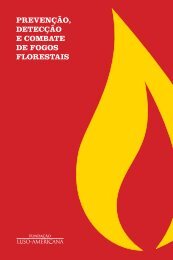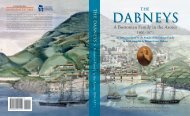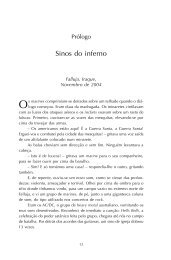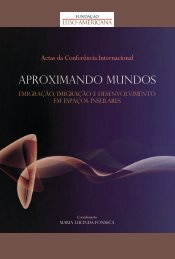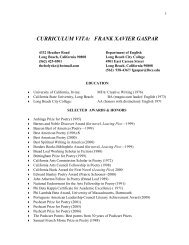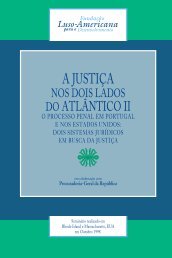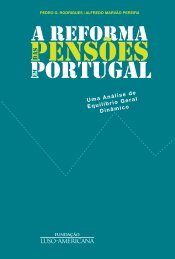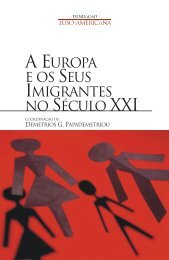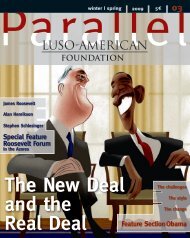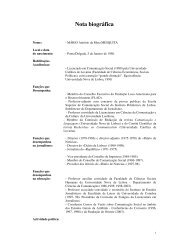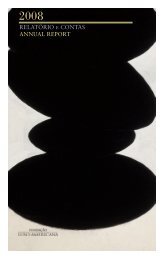A decade later - Fundação Luso-Americana
A decade later - Fundação Luso-Americana
A decade later - Fundação Luso-Americana
Create successful ePaper yourself
Turn your PDF publications into a flip-book with our unique Google optimized e-Paper software.
‘ in the attic in massachusetts<br />
there were “mysterious crates<br />
containing the consul’s ceremonial cap<br />
and sword, a model of a portuguese<br />
whaling ship, and lots of packets of<br />
letters that had been sent by boat”.<br />
’<br />
sally dabney parker<br />
mysTery Boxes<br />
And memorABiLiA<br />
Ceaseless curiosity is something Sally<br />
Dabney Parker has had all her life. She<br />
has researched the family history for<br />
years, and was glad to receive this writer’s<br />
question-filled e-mail. “It’s good<br />
news to know someone is interested in<br />
the Dabneys and their descendants,” she<br />
says. She has spent “years” examining the<br />
items she inherited and entrusting the<br />
documents and objects she owns to the<br />
in 1862, the Horta Town council donated a burial plot<br />
to the family. Two of the fourteen graves belong to the first two<br />
us consuls, John Bass and charles William dabney. This year<br />
the local authorities rehabilitated the spot and published<br />
a small brochure on the dabneys, focusing on the plot<br />
in the carmo cemetery.<br />
72<br />
cuLTure<br />
“right museums.” At 72,<br />
Sally is currently finishing<br />
up a biography of her<br />
great grandfather, Frank<br />
Dabney (1873-1934).<br />
Sally’s childhood was<br />
like something out of C.<br />
S. Lewis, replete with<br />
attics full of strange, dusty<br />
boxes that, when opened<br />
by the children, revealed<br />
wondrously mysterious<br />
objects from far away<br />
times and places. Like<br />
Sally, many of the other Dabneys of her<br />
generation grew up hearing about the<br />
enchanting lives of their ancestors on<br />
Faial. “Many of our homes had a photograph<br />
of the Bagatelle, or a portrait. In<br />
our case, it was a picture of Francis Oliver<br />
Dabney, Roxanna’s brother. There were<br />
other unusual objects like a replica of the<br />
Bagatelle in porcelain, half of an ivory<br />
chessboard, a complete sewing box that<br />
came from the Fredonia, and linen cloths<br />
in “sieve” embroidery (a complex embroidery<br />
technique developed in<br />
northern Portugal). In the attic<br />
in Massachusetts there were<br />
“mysterious crates containing<br />
the consul’s ceremonial cap<br />
and sword, a model of a<br />
Portuguese whaling ship, and<br />
lots of packets of letters that<br />
had been sent by boat.” When<br />
Sally was a little girl, her great<br />
aunt Edith Dabney Ford gave<br />
her scores of objects that had<br />
come to the US from the family’s<br />
estates in Faial. Many of<br />
them had once belonged to<br />
Sariha Dabney, a sister of<br />
Edith’s who had died at 16,<br />
and whose initials – S. D. –<br />
Sally shared.<br />
From a childhood spent<br />
among mysterious objects,<br />
crates in the attic, and a collection<br />
of memorabilia from<br />
a long-dead relative who<br />
shared her initials, grew a passionate<br />
curiosity about the<br />
past that Sally has nurtured<br />
throughout her life. After her<br />
children had grown, she started<br />
working in an architect’s<br />
studio where she began to<br />
uncover the family’s history.<br />
Apparently, when they<br />
returned to the US in 1892,<br />
the Dabneys settled in<br />
California where, as Sally<br />
recounts, “The climate<br />
sally dabney, 72, has spent years researching<br />
the family’s history and heritage. every year she<br />
and her cousins meet to reminisce and exchange<br />
old family photos. sally is currently finishing a<br />
biography of her great-grandfather Frank dabney.<br />
reminded them of the Azores.” There, one<br />
of the recent arrivals built the Fayal Ranch.<br />
The following generations (Frank, Bert,<br />
and John) also fared well: one built a winery<br />
and <strong>later</strong> a railway line in California;<br />
while another one devoted himself to the<br />
import-export business and the third to<br />
architecture. “All of the boys got a college<br />
education, most from Harvard and two<br />
from MIT.”<br />
Sally Dabney has donated most of the<br />
objects and letters to the Peabody Essex<br />
Museum in Salem. She refuses to let such<br />
a fascinating past fall into oblivion. Every<br />
year, she and two cousins get together<br />
to bridge the time warp by remembering<br />
stories, and exchanging photos and family<br />
treasures. And like Fred, Sally also<br />
made the pilgrimage to Faial, but in<br />
1974. “I went with my mother, brother,<br />
and cousin – all Dabneys. We had a beautiful<br />
tour inside the Bagatelle and the<br />
Cedars. But then there was a kind of<br />
Communist take-over that week, and we<br />
were advised to leave immediately. What<br />
an adventure!” she writes from her summer<br />
home in Maine, many miles away,<br />
and many years removed from the treasures<br />
in the attic.<br />
DR<br />
one of sally’s treasures: an 1862 medal won<br />
by c.W. dabney & sons of Faial at a wine<br />
competition in London.<br />
Parallel no. 6 | FALL | WINTER 2011<br />
DR





